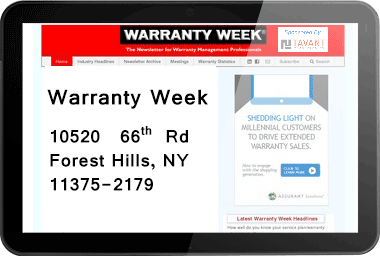 Warranty Week
Warranty Week
Light and Dark Theme
Click to toggle the mode to your preference
Contact Warranty Week
Subscribe to Warranty Week's Newsletter
In our 22nd year of providing the latest & greatest Warranty Information.
-
From Binge-Watching to Smart Living: The Subscription Shift at CES 2026: This article by Dawn Taylor, SVP of Strategic Growth at Domestic & General, explores how subscription service models are reshaping loyalty, retention, and long-term value for OEMs and retailers, and why brands that prioritize proactive service and recurring engagement will define the next era of smart living.
Dec 18, 2025
-
Nine-Month Top 100 Warranty Providers of 2025: 44 of the top 100 American warranty-issuing manufacturers made at least one appearance in our charts showing the largest increases and reductions in warranty costs. Nvidia, Shoals Technologies, and TPI Composites made three appearances in our nine-month charts.
Dec 11, 2025
-
Credit Card Extended Warranty: A wide variety of U.S.-issued credit cards offer extended warranty coverage as an ancillary benefit, for electronics and appliances purchased with the card. We perused the Guides to Benefits of dozens of major credit cards across three card networks and seven card issuers, and found the policy terms, administrators, obligors, and underwriters.
Dec 4, 2025
-
Worldwide Heavy Equipment Warranty Report: In 2024, the top global heavy equipment manufacturers paid about $6.15 billion in warranty claims, with an average claims rate of 1.37%, and set aside about $6.51 billion in warranty accruals, with an average accrual rate of 1.45%.
Nov 27, 2025
-
Worldwide Jet Engine Warranty Expenses: In 2024, the global aircraft engine manufacturers paid $1.004 billion in warranty claims, with an average warranty claims rate of 0.81%, and set aside $1.16 billion in warranty accruals, with an average warranty accrual rate of 0.93%.
Nov 20, 2025
-
Commercial Aviation Warranty Expenses: The 21st century of commercial aviation has been dominated by several high-profile warranty problems, from the Boeing 787 Dreamliner delays and 737 MAX groundings, to the Airbus A380 program ceasing. This week, we're taking a look at the history of commercial aviation, and the market conditions and other factors that led to this industry being categorized by extreme periods of warranty costs.
Nov 13, 2025
-
Worldwide Aviation Warranty Expenses: The global airframe manufacturers paid about $1.13 billion in warranty claims in 2024, with an average claims rate of 0.76%, and set aside about $1.08 billion in warranty accruals, with an average accrual rate of 0.73%. 2024 was the second year in a row in which claims exceeded accruals.
Nov 6, 2025
-
Kawasaki introduces 10-year motorcycle extended warranty in India.
Hindustan Times (IN), Dec 19, 2025
-
Chef's Deal restaurant equipment introduces CPS extended warranty program.
Press Release, Dec 18, 2025
-
PigTek offers new 5-year limited warranties on feed line products.
Press Release, Dec 17, 2025
-
Airinmar signs multi-year service contract deal with helicopter operator Air Methods.
Press Release, Dec 16, 2025
-
Warranty stats compare AMD and Intel GPUs.
PC Guide, Dec 16, 2025
-
BYD increases Europe EV battery warranty to 8 yrs/ 250,000 km, surpassing Tesla's.
Electrek, Dec 15, 2025
-
Lucid starts selling pre-owned EVs, offers extra year of warranty coverage.
Electrek, Dec 15, 2025
-
Mechanic catches warranty fraud attempt in viral TikTok.
Motor 1, Dec 15, 2025
-
Warranty Solutions Group expands into motorcycle market.
Superbike News, Dec 15, 2025
-
GM denied Corvette extended warranty claim after spotting non-standard bolt.
CarScoops, Dec 14, 2025
-
Tesla launches battery extended warranty for U.S. and Canada.
Tesla North, Dec 13, 2025
-
Chevrolet Philippines rolls out maintenance promo for out of warranty vehicles.
Zigwheels (PH), Dec 12, 2025
-
NY Ford dealerships file class action lawsuit alleging EV battery work was underpaid.
Press Release, Dec 10, 2025
-
Howden backs cross-border extended warranty program for Chinese EVs sold in Thailand.
Insurance Business Magazine, Dec 10, 2025
-
Google starts repair program for Pixel 9 Pro, extends Pixel 9 Pro Fold warranty.
9 to 5 Google, Dec 8, 2025
Worldwide Heavy Equipment Warranty Report:
In 2023, the worldwide heavy equipment industry paid $4.6 billion in warranty claims, and set aside $6.6 billion in warranty accruals. The average claims rate was 1.17%, and the average accrual rate was 1.4%.
While the warranties issued for passenger cars and light trucks get all the attention, there is a huge warranty chain management operation on the commercial side, for the heavy equipment used in industries including construction, agriculture, and mining.
We're tracking the top 57 heavy equipment manufacturers worldwide, of which 23 include their warranty expense figures in their annual reports. Together, we estimate, these 23 OEMs accounted for about 83% of the worldwide heavy equipment industry's warranty expenses last year. So it's relatively easy to fashion estimates for the remaining 17%, and to create a report on their global warranty expenses.
Worldwide Auto Warranty Report:
In 2023, the global automotive manufacturers paid $51 billion in warranty claims, with an average claims rate of 1.98%, and set aside $65 billion in warranty accruals, with an average accrual rate of 2.52%. At the end of 2023, the worldwide automakers held a total of $140 billion in warranty reserves.
In 2023, the global automotive industry saw significant increases in three of our five key warranty metrics: claims paid, accruals made, and reserves held. Global automotive product warranty claims paid and accruals made both grew by 17% from 2022 to 2023, while warranty reserves held by global automotive manufacturers increased by 14%. At the same time, the industry average claims and accrual rates increased only slightly, meaning vehicle sales revenue grew parallel to increases in warranty costs.
Warranty Week tracks the warranty expenses of 34 major automotive manufacturers around the world, which report some or all of their warranty metrics to investors in their annual reports. Most report the amount they pay in claims, the amount of accruals they make, and the end-balance of the warranty reserve fund.
Twenty-Second Annual Product Warranty Report:
In 2024, the over 1,400 U.S.-based, warranty-issuing manufacturers we track paid an average of 1.329% of their total product sales revenue on warranty claims, and an average of 1.333% of their sales revenue on warranty accruals. Companies in the vehicle, electronics, and building trade sectors set aside $31.041 billion in warranty accruals, paid $29.176 billion in warranty claims, and collectively held $60.839 billion in warranty reserves at the end of the year.
The SEC annual report filing deadline for large companies was March 3, and the deadline for all filers was March 31. We've gathered data from all but a small handful of manufacturers that will file late, or perhaps not at all. And we can say with confidence that we've gathered over 99% of all available product warranty expense data from U.S.-based, warranty-issuing manufacturers. For the twenty-second consecutive year, we are happy to present our Annual Product Warranty Report.
For over two decades, we've tracked the product warranty expenses of over 1,400 U.S.-based manufacturers. This week, we're kicking off our series of 22-year charts with this overview of product warranty expenses by industry group. Over the coming months, we will delve deeper into the expenses of the companies comprising each of these industries.
World's Largest Warranty Problems:
On the one hand, U.S.-based manufacturers are required to disclose their warranty expenses to investors. On the other hand, they try their best to obscure the news and bury it in plain sight when something really expensive happens. But as the saying goes, a picture's worth a thousand words. And in the charts that follow, it's hard to hide a billion-dollar warranty problem.
Over the past few years, every once in a while, a set of warranty expense numbers comes in that makes us wonder if there's been a typographical error in a company's annual report. Suddenly, there's a billion-dollar warranty expense and there's no explanation at all anywhere in the document.
Other times, a major safety recall or some other big event makes the news, and inevitably it gets reduced into a major escalation in a company's warranty expenses. For these, we don't need any additional explanations, but we never do find out exactly how much it costs.
Warranty Expenses When Conglomerates Break Up:
In early 2020, two diversified companies spun off product lines to become "pure plays" in specific industries. And now, seven quarters later, the warranty expense metrics of the five new companies, which were previously blended together, have diverged in very distinct ways.
After news broke last month about the plans of General Electric Company and Johnson & Johnson to break themselves into three and two companies, respectively, it made us recall the break-ups of last year, when United Technologies Corp. and Ingersoll-Rand plc reorganized themselves into three and two units.
As we wrote about in the May 28, 2020 newsletter, our main interest in the break-ups of these conglomerates was how their subsequent financial statements would allow us to get a much clearer view of their warranty expenses, since the aerospace claims and accruals would no longer be blended with those of the air conditioning or industrial/building products lines of business. And now, with nearly two years of separate data in hand, that clearer picture has emerged.
Light and Dark Theme
Click to toggle the mode to your preference







